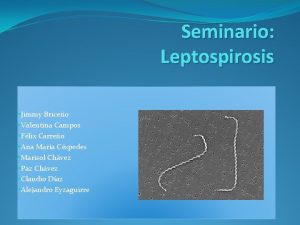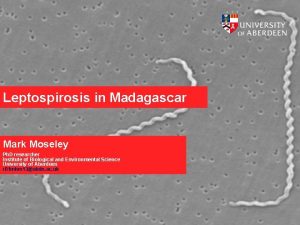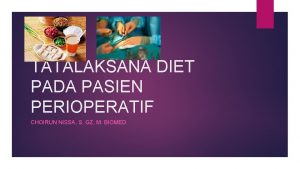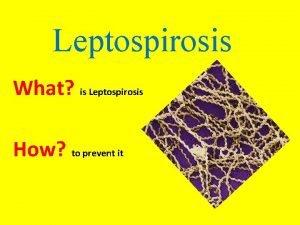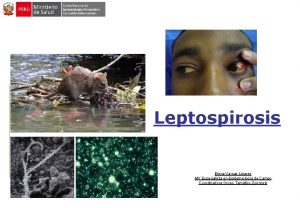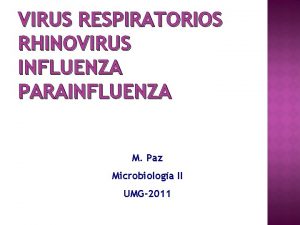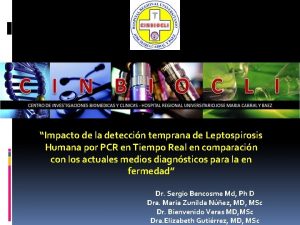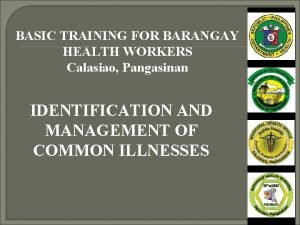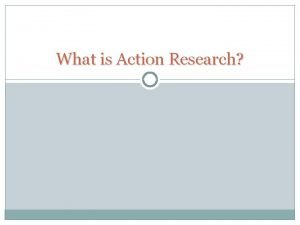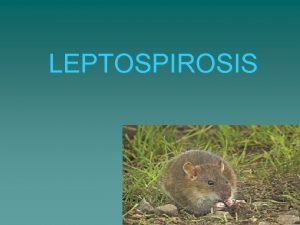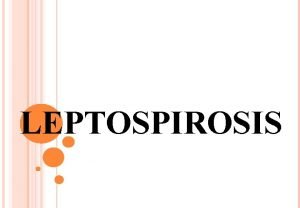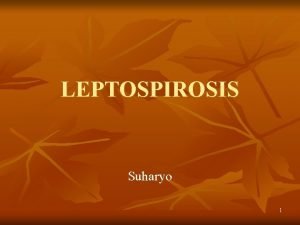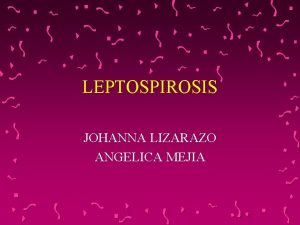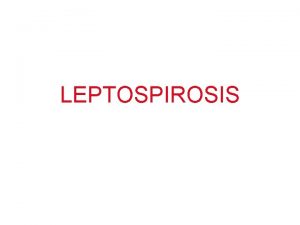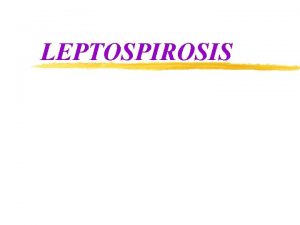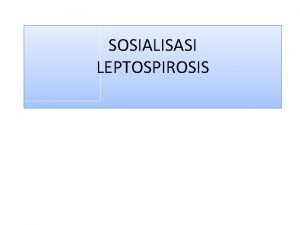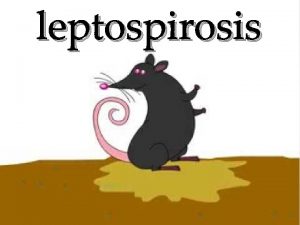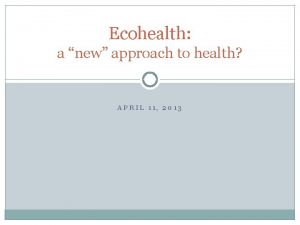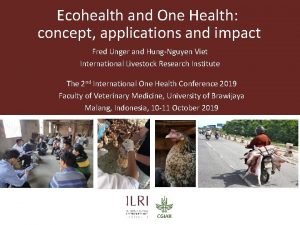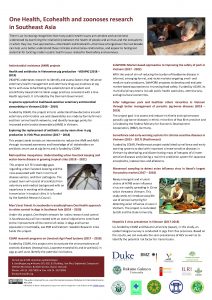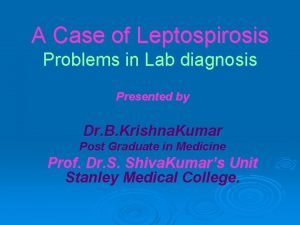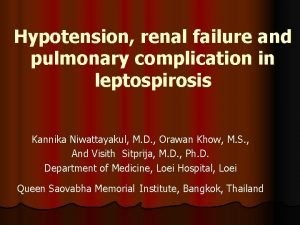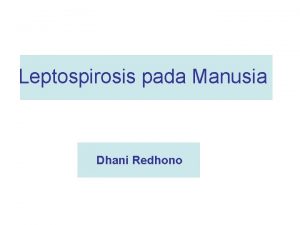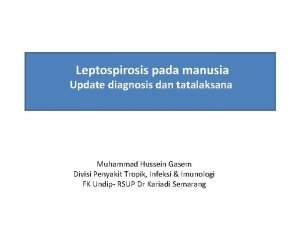CASE STUDY OF LEPTOSPIROSIS USING AN ECOHEALTH APRROACH
























- Slides: 24

CASE STUDY OF LEPTOSPIROSIS: USING AN ECOHEALTH APRROACH FOR BETTER MANAGEMENT OF LEPTOSPIROSIS IN KULONPROGO DISTRICT, YOGYAKARTA SPECIAL PROVINCE, INDONESIA EHRC UGM Dyah Ayu Widiasih Presented on Eco. Health-One Health Short Course, Hanoi 27 -30 May 2013

Background In 2009, there were outbreaks of leptospirosis in Yogyakarta ECOHEALTH CONCEPT APPROACHES INTEGRATIVE RESEARCH Leptospirosis = ZEID Ministry of Agriculture Priority of controlliing EID Priority zoonoses in Indonesia: Leptospirosis 3 rank (MOH) NEED NEW APPROACHES FOR BETTER CONTROLLING

Eco. Health Approaches to Solve Risk Factors of Leptospirosis Progo river

Eco. Health Approaches to better control Leptospirosis Eco. Health Aspects of Leptospirosis Research Focus on the following: • Collaboration with transdisciplinary team • Articulation of an Eco. Health conceptual framework • Understanding Leptospirosis risk factors & policy issues • Understanding cultural landscape & policy context of Leptospirosis • Engaging in regional exchange /work on Leptospirosis

Groups involved - Framework Public health authorities (municipal health services) Livestock services Farmers (dairy cattle, goat, sheep) & pet owners The problem: Leptospirosis in Yogyakarta Head of District UGM (implementing the project) 7 faculties: Vet Med, Animal Science, Social Science (Anthropology) & Medicine, Geography, Biology,

Boundary Partners • Some faculties at UGM • Municipal Health of Yogyakarta Special Province • Livestock services of Yogyakarta Special Province • Community

Materials and Methods Phase 1 • Surveillance and screening agents from animals • Questionnaires for demographic data and potential risks from animals • Spatial analysis Phase 2 • Exploring risk factors: • Knowledge of zoonotic diseases & leptospirosis • Behavior of people • Control & prevention • Stakeholder policy

Materials and Methods (Phase 1) -Cattle sera: -Sampling design High human cases area along the watershed of Progo River Kulon Progo, Bantul, Sleman • Leptospirosis prevalence • Risk factors: • hosts • environments • socio-economics • Mapping disease Kulon Progo district

Preliminary Results – Leptospirosis Serology Prevalence observed: 1. Cattle 1. Sheep & goat 2. Dog & cat : 10% (out of 500 cattle sera analyzed so far 50 have been tested positive) : 1. 6% (1/60) : 0% (0/60)

Preliminary Results – Leptospirosis Serology Leptospirosis serovars 5% 4% 2%2%2% 16% % serovar 52% 18% Leptospira serovar hardjo Leptospira serovar icterohaemorrhagiae Leptospira serovar rachmatie Leptospira serovar battaviae Leptospira serovar javanicae Leptospira serovar pomona Leptospira serovar celledoni Leptospira serovar tarrasovi

Positive Areas Based on MAT Analysis No. 1 Subdistrict No. of cases Seworan, Triharjo, Wates Block IV, Karangwuni, Wates Kriyanan, Wates X, Pleret, Panjatan Bojong 3, Bojong, Panjatan Temben, Ngentakrejo, Lendah Kutogiri, Sidomulyo, Pengasih Mrungi, Sendangsari, Pengasih Kisik, Banjarasri, Kalibawang Krikil, Pendoworejo, Girimulyo 7 1 1 11 1 3 1 1 2 1 1 1 3 1 2 1 1 1 6 1 1 1 2 2 1 2 3 4 5 6 7 8 9 10 11 12 Wiyu, Kembang, Nanggulan Duwet, Purwoharjo, Samigaluh Serovars Leptospira serovar hardjo Leptospira serovar icterohaemorrhagiae Leptospira serovar hardjo Leptospira serovar javanicae, L. celledoni Leptospira serovar icterohaemorrhagiae Leptospira serovar hardjo Leptospira serovar battaviae Leptospira serovar tarrasovi Leptospira serovar hardjo Leptospira serovar battaviae Leptospira serovar icterohaemorrhagiae Leptospira serovar rachmatie Leptospira serovar hardjo Leptospira serovar battaviae Leptospira serovar rachmatie Leptospira serovar hardjo Leptospira serovar javanicae Leptospira serovar icterohaemorrhagiae Leptospira serovar rachmatie Leptospira serovar hardjo Leptospira serovar pomona

Results - Demographic Data of Farmers Involved in the Study (QX) Age Education % Age 3. 50 65. 03 7. 69 31. 47 ≤ 45 46 -55 ≥ 55 36. 36 % Occupation 2. 80 Farmers 97. 20 Traders/Enter preneurs % Education 3. 50 52. 45 Not passed Primary School Elementary School High School & higher

Potential Human - Risk Factors for Leptospirosis

Potential Risk Factors for Leptospirosis in Animals • Grazing at pasture • Bath in the river • Work in the rice field • Feed (grass) from the field have many wild mice • Many mice at the ware house • Number of sick cattle and tested positive for leptospirosis • (MAT currently applied)

The distribution of leptospires in Kulon Progo in animals. Positive cases distributed around the river and carried buffer (distance positive leptospirosis cases with watershed) : 1. At a distance of 50 meters 2. At a distance of 100 m 3. At a distance of 200 m 4. Distances greater than 300 m

Phase 2: Results of FGD and IDI • Knowledge of zoonotic disease and leptopsirosis • Behaviour of people • Control and measure • Stake holder policy

Knowledge of Zoonotic Disease and Leptospirosis • Mostly people understand • Familiar zoonotic disease: AI, Rabies • Rat disease • Distribution

Behaviour of People • Unhealthy behaviour through garbage outside house, no washing hand • No protective cloth (boot, etc) during work • Ignore to the death rats

Control and Prevention • Natural predator: snake, owl, garangan (Herpertes javanicus) • Killing • Burning • Bombing (being burned by traditional fireworks)

Control and Prevention Obstacles : • The natural predators are caught and sold by people • The boots often stuck in the mud of paddy field makes the farmers not eager to wear them • The rats ate motorcycles and other various cables

Stakeholder Policies • Socialization • Free medication service program • Eradication program

CONCLUSION The synthesis from the qualitative & quantitative surveys data will contribute to a better integrated understanding of disease emergence and the basis for a more effective addressing of public health policy concerns in order to better management of the disease.

Acknowledgement This work was supported by International Livestock Research Institute (ILRI) and International Development Resource Centre (IDRC). We are grateful to all ILRI representatives in South East Asia, the head of Kulon Progo districts and all staff of Kulon Progo Livestock Services and Municipal Health Services of Kulon Progo for providing the fascilities and secondary data. The grateful thanks to all member of Working Group of EHRCUGM for being a good collaboration team in this study. For more information please visit: www. ilri. org/ecozd www. ilriasia. wordpress. com/tag/ecozd www. ecohealth. fkh. ugm. ac. id

THANK YOU
 Diagnostico de leptospirosis
Diagnostico de leptospirosis Leptospirosis
Leptospirosis Tujuan diet pra bedah
Tujuan diet pra bedah Leptospirosis
Leptospirosis Leptospirosis
Leptospirosis Leptospirosis complicaciones
Leptospirosis complicaciones Leptospirosis complicaciones
Leptospirosis complicaciones Paano nakakahawa ang leptospirosis
Paano nakakahawa ang leptospirosis Best worst and average case
Best worst and average case It project failure case study
It project failure case study Long case and short case
Long case and short case Best average and worst case complexity of binary search
Best average and worst case complexity of binary search Case western reserve university case school of engineering
Case western reserve university case school of engineering Bubble sort best case and worst case
Bubble sort best case and worst case Bubble sort best case and worst case
Bubble sort best case and worst case Bubble sort best case and worst case
Bubble sort best case and worst case Ambiguous case of law of sines
Ambiguous case of law of sines Using system using system.collections.generic
Using system using system.collections.generic Dtfd switch
Dtfd switch Zara management information system
Zara management information system Yelp case study presentation
Yelp case study presentation Kf case study memory
Kf case study memory Swot analysis of whole foods
Swot analysis of whole foods Action research vs case study
Action research vs case study Volkswagen of america managing it priorities
Volkswagen of america managing it priorities
